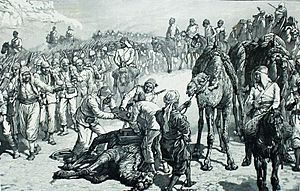Battle of Shaykan facts for kids
Quick facts for kids Battle of Shaykan |
|||||||
|---|---|---|---|---|---|---|---|
| Part of the Mahdist War | |||||||
 Hicks Pasha's army |
|||||||
|
|||||||
| Belligerents | |||||||
| British empire | |||||||
| Commanders and leaders | |||||||
| Hicks Pasha † | Mohammed Ahmed | ||||||
| Strength | |||||||
| 10,000 infantry, 1,000 cavalry, 100 warriors, 14 artillery pieces, 6 machine guns |
~40,000 warriors | ||||||
| Casualties and losses | |||||||
| 7,000 killed unknown wounded, ~2,000 captured |
280 killed ~600 injured |
||||||
The Battle of Shaykan was a major fight that happened between November 3 and 5, 1883. It took place in the woods of Shaykan, near the town of El-Obeid in Sudan. One side was led by an Egyptian commander named Hicks Pasha. The other side was led by Muhammad Ahmad, who called himself the Mahdi, a religious leader. The Mahdi's forces won this important battle.
Contents
What Led to the Battle?
The Mahdi's Growing Power
In 1881, a religious leader named Muhammad Ahmad declared himself the Mahdi. This means he claimed to be a special guide for Muslims. He started gathering followers in an area of Sudan called Kordofan. Soon, his group grew into a large army.
The Egyptian government, which controlled Sudan at the time, tried to stop him. They sent 4,000 soldiers to capture him. But the Mahdi's forces surprised them near El Obeid. The Egyptian army was completely defeated, and the Mahdi's fighters took all their weapons. This victory made the Mahdi's army even stronger.
Egypt's Plan to Fight Back
The Egyptian Governor, Rauf Pasha, decided he had to fight the Mahdi. He started to put together his own army. He hired European officers, including a retired British colonel named William "Billy" Hicks. Hicks had experience fighting in places like India.
Most of the Egyptian soldiers in Hicks' army had been in prison. They were released to fight in Sudan. Because of this, they weren't very eager to fight. At first, they stayed near Khartoum, the capital. They had a few small fights with the Mahdi's forces and managed to push them back.
Marching to El Obeid
Later in 1883, the Egyptian officials heard that the Mahdi was attacking El Obeid. This was an important town in Kordofan. They decided to send Hicks' army to capture the Mahdi and help the town. Hicks was not sure this was a good idea, but the plan went ahead. The army had to march about 200 miles from their camp to reach El Obeid.
The Battle of Shaykan
Hicks' Army on the March
The army Hicks led into Kordofan was quite large. It had about 8,000 regular Egyptian soldiers. There were also 1,000 horsemen called bashi-bazouks and 100 tribal fighters. About 2,000 other people, like cooks and helpers, also traveled with the army.
They carried enough supplies for 50 days. This meant they needed 5,000 camels to carry everything! The army also had 10 mountain guns, 4 larger field guns, and 6 machine guns. Another Englishman, Colonel Farquhar, was Hicks' chief of staff.
By the time they started their march, El Obeid had already fallen to the Mahdi. But the mission continued. The goal was now to help Slatin Bey, who was the Governor of Darfur.
A Difficult Journey
This army was not in good shape. As Winston Churchill later described it, it was "perhaps the worst army that has ever marched to war." The soldiers were not paid well, not trained properly, and didn't follow orders very well. Many of them felt more like the enemy than their own officers.
Their guides, either by mistake or on purpose, led them off the right path. Soon, the army found itself surrounded by the Mahdi's forces. The Egyptian soldiers became very scared and many started to run away.
The Final Fight
After marching for some time, the entire Mahdist army attacked them on November 3. The Egyptian forces quickly formed a defensive square shape to protect themselves. Reports from Britain said that this square held for two days. But finally, it broke apart.
About one-third of the Egyptian soldiers gave up. They were later set free. However, almost all the officers, including Hicks Pasha, were killed. Only about 500 Egyptian soldiers managed to escape and make it back to Khartoum. Famous journalists like Edmund O'Donovan and Frank Vizetelly were also killed during the battle.
After the Battle
The Mahdi's victory at Shaykan was a huge success for him. After the battle, the Mahdist army used El Obeid as a main base for their operations. This success also encouraged other groups to join the rebellion. One of these was the Hadendoa tribe, led by Osman Digna. These fighters, sometimes called fuzzy-wuzzies, joined the Mahdi's cause from their lands near the Red Sea.
See also
- Henry Vizetelly

